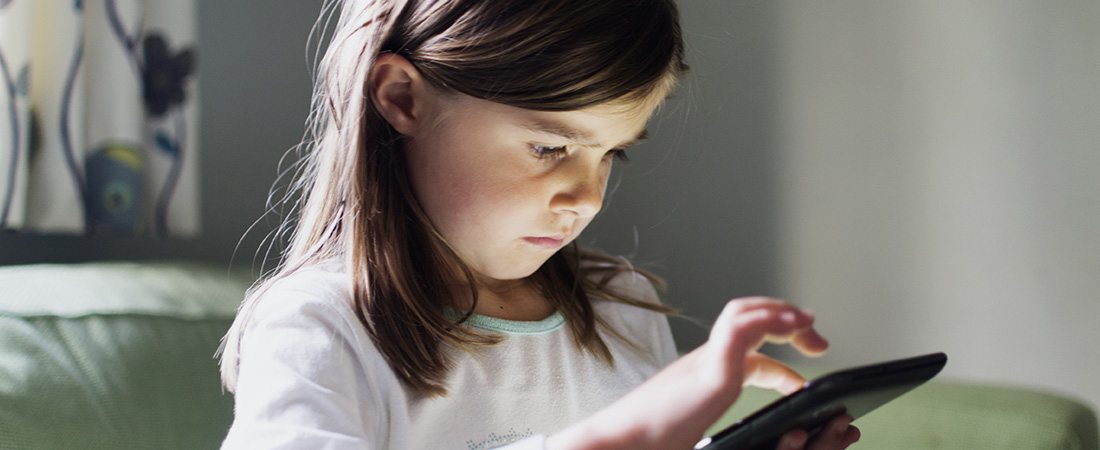Little Hands, Big Screens

In 2012, NAEYC and the Fred Rogers Center released a joint position statement about the use of technology in early childhood settings. Their recommendations included the following1:
1. Select, use, integrate, and evaluate technology and interactive media tools in intentional and developmentally appropriate ways, giving careful attention to the appropriateness and the quality of the content, the child’s experience, and the opportunities for co-engagement.
2. Provide a balance of activities in programs for young children, recognizing that technology and interactive media can be valuable tools when used intentionally with children to extend and support active, hands-on, creative, and authentic engagement with those around them and with their world.
3. Prohibit the passive use of television, videos, DVDs, and other non-interactive technologies and media in early childhood programs for children younger than 2, and discourage passive and non-interactive uses with children ages 2 through 5.
1 National Association for the Education of Young Children and the Fred Rogers Center for Early Learning and Children’s Media at Saint Vincent College. (2012). Technology and interactive media as tools in early childhood programs serving children from birth through age 8. Retrieved from http://www.naeyc.org/files/naeyc/
PS_technology_WEB.pdf
The newest tablets and smartphones are so intuitive that toddlers can swiftly learn to operate them. And for many harried parents and caregivers, such ready access to entertainment can be a blessing. But is all of this exposure to technology by its earliest adopters a good thing?
EDC’s Shelley Pasnik has long been interested in how children can use technology to make sense of the people and events in their lives. She thinks that more emphasis should be placed on how young children are interacting with these new devices, not just the length of time they spend with them.
Q: In a world of screens, can there be too much “screen time”?
Pasnik: In any conversation about screen time as it relates to young children, it’s important to distinguish between the kinds of interactions going on. Some are ones to encourage. Is it information seeking? Is it self-expression? Is it having a sense of others, as in a video call with a family member? All of these invite different considerations about how much use is appropriate.
Focusing on the idea of limiting “screen time” places emphasis solely on the device and the amount of time that a child is using it. If you’re only thinking about what happened when the children’s eyes were looking down on this backlit seven-inch screen, then you’re missing a lot of opportunities to talk about all of the different formats and genres that are available on these screens.
Q: Is there a common-sense set of guidelines to using media and technology with young kids?
Pasnik: The American Academy of Pediatrics has recommended that children under two do not watch television or use electronic media. The policy was meant to favor face-to-face social interactions, but it has received a lot of attention because it draws such a bright line with respect to technology. And I think a lot of parents and educators want a more nuanced approach to media that takes into consideration how people are really living and how the devices are actually being used.
The Fred Rogers Center and the National Association for the Education of Young Children (NAEYC) took this into consideration when they issued a recent set of guidelines about media use and young children. Rather than prohibiting media use, these guidelines encourage thinking about what the educational opportunities are, and how media can be integrated into a healthy childhood. There is greater flexibility and nuance about children’s responsible use of media.
Q: What are some appropriate ways to integrate technology devices into preschool?
Pasnik: Our research has shown that media resources should be treated as just one of many tools that a teacher has available. The screen is no more special than the box of colored pencils, the block area, or the water table. It’s something that kids move fluidly in and out of, allowing them to practice certain skills.
I recently participated in a panel held by the New America Foundation titled Beyond Screen Time. One of the other panelists shared a video of a preschool classroom that used technology in an age-appropriate and compelling way. A child would sit in front of a computer and, with the teacher’s help, take a picture of something they experienced that day and record a message—something of interest to the child. And then that “Message from Me” would be e-mailed to the parent. I think that’s a terrific use of technology because it is facilitating communication, and because it is a shared experience between the teacher, student, and home.
Q: Do you see any danger in the constant presence of tablets, televisions, phones, and other types of screens?
Pasnik: I think the current discussions about the omnipresence of technology are analogous to conversations we used to have about background TV, which research found to have detrimental effects. With smartphones and other devices, the concern is that we become distracted if there is this slow burn of an always-on device. But the concern is probably more on the parent side—the parent might not be focusing on what the child is doing or the conversation they are having. It’s hard to interact when a good part of your focus is elsewhere. So for both kids and adults, the challenge is in finding a way to integrate these devices into our lives in a healthy way.